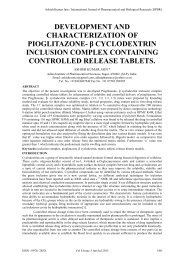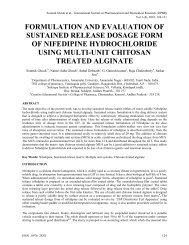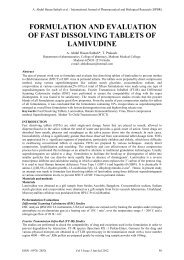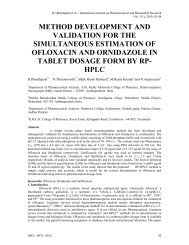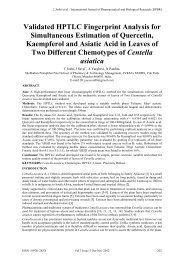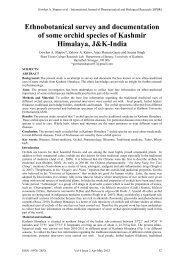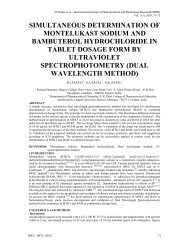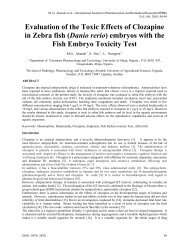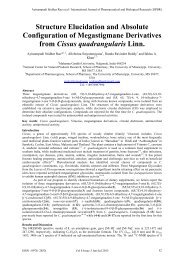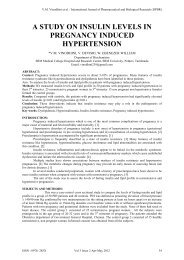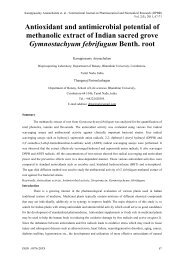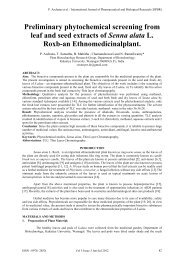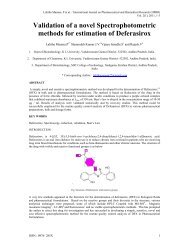Validated HPLC fingerprint analysis for Simultaneous Determination ...
Validated HPLC fingerprint analysis for Simultaneous Determination ...
Validated HPLC fingerprint analysis for Simultaneous Determination ...
Create successful ePaper yourself
Turn your PDF publications into a flip-book with our unique Google optimized e-Paper software.
R. Shah et al. / International Journal of Pharmaceutical and Biological Research (IJPBR)<strong>Validated</strong> <strong>HPLC</strong> <strong>fingerprint</strong> <strong>analysis</strong> <strong>for</strong><strong>Simultaneous</strong> <strong>Determination</strong> of Quercetinand Kaempferol in Methanolic Extract ofTridax procumbensR. Shah, N. Sharma, V. Patel, J. Savai, *Saraswathy N.Department of Pharmaceutical Sciences, SVKM’s NMIMS, Shobaben Pratabhai Patel School of Pharmacy &Technology Management,Mumbai - 400056, India.saraswathy76@yahoo.co.in.ABSTRACTAim: A rapid, sensitive and accurate Reversed Phase-High Per<strong>for</strong>mance Liquid Chromatography method (RP-<strong>HPLC</strong>) with Photo-diode array Detection (PDA) was developed and validated <strong>for</strong> the simultaneousdetermination of Quercetin and Kaempferol in the methanolic extract of Tridax procumbens plant.Method: Whole plant of Tridax procumbens was collected from Dhule District, Shirpur; dried and methanolicextract was prepared and analyzed <strong>for</strong> the presence of standards - Quercetin and Kaempferol using TLC and RP-<strong>HPLC</strong> method and detected at λ=240nm.Results: The R f values <strong>for</strong> Quercetin, and Kaempferol was 0.35 and 0.48 respectively. There was a linearrelationship between chromatographic area and concentration of analytes over the concentration range 1-40µg/ml <strong>for</strong> both, Quercetin and Kaempferol with the retention time of about 8.9 minutes and 10.6 minutesrespectively and correlation coefficient of linear regression <strong>analysis</strong> was found to be r 2 = 0.999 and detectionlimits were between 0.164-0.289µg/ml <strong>for</strong> Quercetin and 0.497-0.816 µg/ml <strong>for</strong> Kaempferol. The averagepercentage recovery was found to be 98.02% and 98.80% <strong>for</strong> Quercetin and Kaempferol respectively.Conclusion: The RP-<strong>HPLC</strong> method developed was found to be simple, sensitive, precise and accurate <strong>for</strong>routine quality control of the powder of whole plant of Tridax procumbens.KEYWORDS: Linear, Recovery, Simple, Sensitive, precise.INTRODUCTIONTridax procumbens Linn.(Compositae) is a weed popularly known as 'Coat buttons' in English because of theappearance of its flowers and is also commonly known as ‘Ghamra’ in Hindi [1, 2] (Fig.1). The plant isindigenous to tropical America and naturalized in tropical Africa, Asia, Australia and India. In India it isconsidered as a wild herb. Coat buttons is also found along roadsides, waste grounds, dikes, railroads,riverbanks, meadows, and dunes. Its widespread distribution and importance as a weed are due to its spreadingstems and abundant seed production [3].Morphology of Tridax procumbens consists of a week herb of about 12-24cm long with few leaves 6-8cm longand very long slender solitary peduncles a foot long and more. Leaf is simple, opposite, exstipulate, ovate, acute,inflorescence capitulum. Tridax has two types of flowers ray-florets and disk-florets, basal placentation and fruitis cypsela [4].Tridax procumbens is also used extensively as 'Bhringraj' in ayurvedic medicine <strong>for</strong> liver disorders and as ananti-diabetic agent [5, 6]. Whole plant of Tridax has been reported <strong>for</strong> its antimicrobial activity on variousGram positive and Gram-negative bacterial species [7]. It is used as bio-adsorbent <strong>for</strong> chromium (VI) which isone of the highly toxic ions released into the environment through leather processing and chrome platingindustries [8]. Various other pharmacological activities like hypotensive, hair growth promoting, wound healing,anti-inflammatory, immunomodulatory and antioxidant activity have also been reported so far [9, 10, 11, 12,13].The phytochemicals present in it are alkaloids, carotenoids, flavonoids (catechins and flavones) and tannins. Itrichly contains carotenoids and saponins [14, 15]. Leaf of Tridax procumbens mainly contains crude proteins26%, crude fiber 17% soluble carbohydrates 39% calciumoxide 5%; luteolin, glucoluteolin, Quercetin andisoquercetin have been reported from its flowers. Whereas the fumaric acid, β-sitosterol and tannin has alsobeen reported in the plant [16].Quercetin, a flavonol, is a plant-derived flavonoid found in fruits, vegetables, leaves and grains. It may also beused as an ingredient in supplements, beverages or foods. Quercetin has been shown to be used <strong>for</strong> treatment ofcancer and fibromyalgia, as an antiviral and as an anti-inflammatory.ISSN : 0976- 285X Vol 3 Issue 4 Aug-Sep 2012 166
R. Shah et al. / International Journal of Pharmaceutical and Biological Research (IJPBR)Kaempferol is a natural flavonol, a type of flavonoid, that has been isolated from tea, broccoli, Delphinium,Witch-hazel, grapefruit, cabbage, beans, endive, leek, tomato, strawberries, grapes, brussels sprouts, apples andother plant sources. It is a yellow crystalline solid with a melting point of 276–278 °C. It is slightly soluble inwater but soluble in hot ethanol and diethyl ether [17].Inspite of these known benefits, it is still listed in the United States as a Noxious Weed and is regulated underthe Federal Noxious Weed Act.Quercetin and Kaempferol (Fig.2) are constituents present in the extract of Tridax procumbens and can be usedas markers. In the present research work, RP-<strong>HPLC</strong> method was used <strong>for</strong> the simultaneous estimation ofQuercetin and Kaempferol and the proposed method was validated in accordance with ICH guidelines [18].MATERIALS AND METHODSEquipments:TLC plates used were Silica gel 60 F 254 plate of dimension 20 X 20cm, 0.25mm thickness manufactured byMerck KGaA, 64271Darmstadt, Germany. The chromatographic system using <strong>HPLC</strong> equipment Model Series200 EP Diode Array Detector system (Perkin Elmer) was used having system software (Total Chrom Navigator)with Column Kromasil of 4.6 mm × 250 mm (Eka Nobel S-44501, Bohus, Swedan) having particle diameter of5µ.Reagents and materials:Analytical grade methanol, toluene, ethyl acetate, chloro<strong>for</strong>m <strong>for</strong>mic acid and potassium phosphate werepurchased from Qualigens Fine Chemicals, Mumbai, India. Quercetin and Kaempferol standards werepurchased from Sigma Aldrich (USA) and the purity was found to be ≥98% and ≥90% by <strong>HPLC</strong>, respectively.Acetonitrile (<strong>HPLC</strong> grade) was purchased from HiMedia Laboratories Pvt. Ltd.Plant material:Sample of whole plant of Tridax procumbens was obtained from Dhule District, Shirpur and identified andauthenticated by the Department of Botany, St.Xavier’s College, Mumbai.Method of Extraction:The fresh plant of Tridax procumbens were cleaned dried at 60°C and powdered. The extraction was carried outby Cold Maceration technique and Soxhlet extraction. Extraction was carried out using 100gm of powder with1000ml of methanol in a conical flask. Maceration was carried out at ambient temperature, using orbital shaker<strong>for</strong> 36 hrs. The extract was collected and filtered, the filtrate was dried at 50°C under reduced pressure in arotary evaporator. Extraction was also carried out using Soxhlet extraction using 1000ml of methanol as asolvent <strong>for</strong> 9h (3 cycles of 3h). All the extracts collected were dried using a rotary evaporator under vacuum andstored in desiccator in a dry place. All the extracts collected were weighed and the percentage extractive valueof extract was calculated as shown in (Fig. no: 3).Preparation of Standard and sample solutions:The standards of Quercetin and Kaempferol were weighed accurately to 10mg and dissolved in 100ml methanolto make a concentration of 100µg/ml and sonicated <strong>for</strong> 10min. The solutions were cooled to room temperature(28 ± 2°C) and further dilutions (1-40µg/ml) were prepared from the respective standard stock solutions.Dried extract weighing 30mg was dissolved in 1ml methanol (30mg/ml). After filtering through a filter paperand a 0.45µ membrane filter (Millipore), the extract was used <strong>for</strong> further standardization.Chromatographic conditions:Quercetin and Kaempferol were separated using Silica gel 60 F 254 TLC plates of dimension 20 X 20cm, 0.25mmthickness. Mobile phase comprised of Toluene, Ethyl acetate, Methanol and Formic acid in the ratio 4:8:0.5:0.2v/v. A glass trough chamber (20×10×4 cm) was used and saturated <strong>for</strong> 20mins with the stated mobile phase. Thestandard and sample solutions were spotted manually as bands by using capillary tubes (Length-4”, Bore-0.5mm) and separation was carried out by ascending development. The RP-<strong>HPLC</strong> separation was obtained byusing the analytical column Kromasil of 4.6 mm ×250 mm (Eka Nobel S-44501, Bohus, Swedan). The mobilephase was a mixture of Acetonitrile (%B) and 0.01N Potassium phosphate buffer (pH=2.5) (%A) adjusted withorthophosphoric acid in the proportion: (time, %B): 0, 10; 8, 50; 15, 55; 18, 10; 19, 10 (gradient system). Theflow rate of mobile phase was set at 1ml/min and the sample volume was 20µl. All the separations were carriedout at room temperature and detected at λ=240nm.Method validationSpecificity, Linearity and Detection limit:The specificity of the proposed <strong>HPLC</strong> method was ascertained by comparing the UV spectra of the standardsand the sample. Linearity was obtained by injecting 20μl of different concentrations of the standard mixturesolution (1, 2.5, 5, 10, 20 and 40μg/ml) of Quercetin and Kaempferol. A sample solution of methanolic extractISSN : 0976- 285X Vol 3 Issue 4 Aug-Sep 2012 167
R. Shah et al. / International Journal of Pharmaceutical and Biological Research (IJPBR)(30mg/ml) of Tridax procumbens was prepared in methanol and 20μl of this solution was injected. Theprocedure was repeated three times. The chromatograms were obtained and mean Quercetin, Kaempferol peakareas (Y axis) were plotted against the corresponding concentrations (X axis) The Limit of detection (LOD) andLimit of Quantitation (LOQ) were determined as per ICH guidelines [18] using following <strong>for</strong>mulae:LOD = 3.3 σ/ SLOQ = 10 σ/ Swhere σ = the standard deviation of the responseS = the slope of the calibration curve.Precision:Intraday precision was evaluated by <strong>analysis</strong> of six replicate injections of three different concentration mixtures5, 10 and 20µg/ml of both the standards Quercetin and Kaempferol on the same day.Interday precision was evaluated by <strong>analysis</strong> of six replicate applications of standard solution mixtures of sameconcentrations as mentioned above on two different days.Sample <strong>analysis</strong> and recovery:The accuracy of the method was established by per<strong>for</strong>ming recovery experiments at three different levels usingthe standard addition method. In 0.5ml (30mg/ml) of methanolic extract of Tridax procumbens, known amountsof Quercetin and Kaempferol standard mixtures were added (2.5, 5 and 10µg) by spiking. The samechromatographic conditions were maintained as mentioned earlier. The average values of percent recovery <strong>for</strong>Quercetin and Kaempferol were calculated.Acceptance CriteriaAcceptance criteria <strong>for</strong> a procedure’s precision and accuracy must be based on the intended use of the analyticalmethod. Precision showing a relative standard deviation (RSD) of app.
R. Shah et al. / International Journal of Pharmaceutical and Biological Research (IJPBR)Sample <strong>analysis</strong> and recovery:The recovery experiments of the Quercetin and Kaempferol were per<strong>for</strong>med by spiking standards to themethanolic extract and the procedure as mentioned earlier was repeated <strong>for</strong> three times. The recoveries of boththe flavonoids were found within acceptable limits (Table no: 4)DISCUSSIONHerbal drug standardization comprises total in<strong>for</strong>mation on composition of all herbals including analyticaloperations <strong>for</strong> identification and assay of active principles. Chromatographic <strong>fingerprint</strong>ing of herbal medicinesis utilized <strong>for</strong> the authenticity and quality controls of herbal medicines, which has become the most importanttool <strong>for</strong> quality control of traditional herbal medicines. Further, the combination of qualitative <strong>fingerprint</strong>ing andquantitative multicomponent <strong>analysis</strong> is a novel and rational method to address the key issues of quality controlof herbal medicines [20]. High Per<strong>for</strong>mance Layer Chromatography is one of the chromatographic techniquesused to identify and quantify the active principles present in the whole plant of Tridax procumbens with the useof optimized mobile phase ensuring that other interfering phytoconstituents present in the sample extract werewell separated from the phytoconstituents to be analysed, enabling simultaneous quantification. The RP-<strong>HPLC</strong>method developed <strong>for</strong> simultaneous qualitative and quantitative <strong>analysis</strong> of Quercetin and Kaempferol in themethanolic extract of Tridax procumbens plant was found to be simple, specific and precise. Also, the methodwas found to be more sensitive with lower detection limits than the method proposed by Chen J, 2009 [21] andcorrelation coefficients of linear regression <strong>analysis</strong> and recoveries were better as compared to method proposedby Zu Y, 2006 [22]. Furthermore, the method can be used as quality control of Quercetin and Kaempferol in theextract of Tridax procumbens plant.ACKNOWLEDGEMENTWe are thankful to Dr. R.S.Gaud, Dean SPP - SPTM <strong>for</strong> providing necessary facilities and <strong>for</strong> his valuablesupport.REFERENCES[1] Durgacharan, A.B., Suresh, G.K., Rahul, S.A., Antidiabetic activity of leaf extract of Tridax procumbens. International Journal ofGreen Pharmacy 2008, 2, 126-128.[2] Ikewuchi, J.C., Ikewuchi, C.C., Igboh, N.M., Chemical Profile of Tridax procumbens Linn. Pakistan Journal of Nutrition 2009, 8, 548-550.[3] Chauhan, B.S., and Germination, D.E., Ecology of Two Troublesome Asteraceae Species of Rainfed Rice: Siam Weed(Chromolaenaodorata) and Coat Buttons (Tridax procumbens) Johnson Weed Science 2008, 56, 567–573.[4] Khan, S.K., Rahman, A.H., Alam, M.S., Ferdous, A., Islam, A.K., and Rahman, M.M., Taxonomic Studies on the Family Asteraceae(Compositae) of the Rajshahi Division. Research Journal of Agriculture and Biological Sciences 2008, 4(2), 134-140.[5] Pathak, A.K., Saraf, S., Dixit, V.K., Hepatoprotective activity of Tridax procumbens - Part I. Fitoterapia 1991, 62, 307-13.[6] Bhagwat, D.A., Killedar, S.G., Adnaik, R.S., Antidiabetic Activity of leaf extract of Tridax procumbens. International Journal ofGreen Pharmacy 2008, 2, 126-128.[7] Mahato, R.B., and Chaudhary, R.P., Ethnomedicinal study and antibacterial activities of selected plants of Palpa district, Nepal.Scientific World 2005, 3(3), 26-31.[8] Malairajan, S., and Singanan, A.A., Studies on the removal of hexavalent chromium from industrial wastewater by using biomaterials.The Electronic Journal of Environmental, Agricultural and Food Chemistry 2007, 6(11), 342-345.[9] Salahdeen, H,M., Yemitan, O.K., Alada, A.R., Effect of aqueous leaf extract of Tridax procumbens on blood pressure and heart rate inrats, African Journal of Biomedical Analysis 2004, 7, 27-29.[10] Saraf, S., Pathak, A.K., Dixit, V.K., Hair growth promoting activity of Tridax procumbens Fitoterapia 1991, 62, 495-498.[11] Margaret, I., Srinivasa, P.R., Jamil, K., Anti-inflammatory profile of Tridax procumbens in animal and fibroblast cell model,Phytotherapy 1998, 12, 285-287.[12] Agrawal, S.S., Talele, G.S., Surana, S.J., Antioxidant activity of fractions from Tridax procumbens, Journal of Pharmacy Research2009, 2, 7173.[13] Vyas, S.P., Tiwari, U., Rastogi, B., Singh, P., Saraf, D.K., Immunomodulatory effects of aqueous extract of Tridax procumbens inexperimental animals., Journal of Ethnopharmacology 2004, 92, 113-119.[14] Gaind,K.,Ghandi,K.,Juneba,T.,Neilson, B., Tetrahydroxydecyl isothiocyanate derived from Capparis grandi,. Phytochemistry1975, 14,1415-1418.[15] Gadre, A., Gabhe, S.Y., Identification of some sterols of Tridax procumbens by GC‐M, International Journal of Green Pharmacy1993, 55, 191‐192.[16] Verma, R.K, and Gupta, M.M., Lipid constituents of Tridax procumbens. Phytochemistry 1988, 27(2), 459-163.[17] Tandon, N., and Sharma, S., Quality Standards of Indian Medicinal Plants, 2010, 8,(13).[18] ICH Guidelines on Analytical Method Validation, in: Proceedings of the International Convention on Quality <strong>for</strong> the PharmaceuticalIndustry, Toronto, September 2002.[19] Vijayalakshmi, A., Ravichandiran, V., Malarkodi, V., Nirmala, S., Jayakumari, S., Screening of flavanoid Quercetin from the rhizomeof Smilax china Linn. <strong>for</strong> anti-psoriatic activity, Asian Pacific Journal of Tropical Biomedicine 2012, 269-275.[20] Neeraj, C., and Bhupinder, S.S., An overview of advances in the standardization of herbal drugs, J Pharm Educ Res 2011, 2(2), 55-70.[21] Chen, J., Shi, Y., <strong>Determination</strong> of Quercetin and kaempferol in Polygonum aviculare by <strong>HPLC</strong>, Zhongguo Zhong Yao Za Zh 2009,34(4), 423-7.[22] Zu, Y., Li, C., Fu., Y, Zhao, C., <strong>Simultaneous</strong> determination of catechin, rutin, quercetin kaempferol and isorhamnetin in the extract ofsea buckthorn (Hippophae rhamnoides L.) leaves by RP-<strong>HPLC</strong> with DAD, J Pharm Biomed Anal. 2006, 41(3),714-9.ISSN : 0976- 285X Vol 3 Issue 4 Aug-Sep 2012 169
R. Shah et al. / International Journal of Pharmaceutical and Biological Research (IJPBR)Table 1: Validation data from calibration curves of the Quercetin and Kaempferol (n=3).StandardRetentionRegression equationCorrelationLinearLODLOQtime (min)coefficient (R 2 )Range(µg/ml)(µg/ml)(µg/ml)Quercetin 8.9 y = 77512x - 53233 0.999 1 - 40 0.164 0.289Kaempferol 10.6 y = 81393x - 57315 0.999 1 - 40 0.497 0.816X: Concentration (µg/ml), Y: Peak area.Table no. 2: Percentage content of Quercetin and Kaempferol in the methanolic extract of Tridax procumbens plant (n=3).Compound Mean Peak Area ± S.D Content (% w/w)Quercetin 319657 ± 3854.4 1.60Kaempferol 139661 ± 7134 0.81Table no. 3: Intraday and Interday precision (n=6)Compound Concentration (µg/ml) Intra- day R.S.D.For peak area (%)Inter- day R.S.D.For peak area (%)5 0.51 2.78Quercetin10 1.78 2.1120 2.79 2.775 0.78 4.70Kaempferol10 1.28 1.4520 2.04 2.23ISSN : 0976- 285X Vol 3 Issue 4 Aug-Sep 2012 170
R. Shah et al. / International Journal of Pharmaceutical and Biological Research (IJPBR)Table no. 4: Average Percentage Recoveries of Quercetin and Kaempferol in the methanolic extract of Tridax procumbens plant (n=3).Compound Amount present(µg) Amount added(µg) Average Recovery (%)240 2.5QuercetinKaempferol240 5240 10291 2.5291 5291 1098.0298.80Fig.1 Whole Plant of Tridax procumbens.Fig.2 Chemical structure of Quercetin and KaempferolISSN : 0976- 285X Vol 3 Issue 4 Aug-Sep 2012 171
R. Shah et al. / International Journal of Pharmaceutical and Biological Research (IJPBR)Fig. 3 Percentage yield of methanolic extract of Tridax procumbens plant by different Extraction methods.KaempferolQuercetinFig. 4 TLC plate derivitized using Anisaldehyde reagent. Band 1: Standard solution of Quercetin and Kaempferol. Band 2 and 3 methanolicextract of Tridax procumbens plant.ISSN : 0976- 285X Vol 3 Issue 4 Aug-Sep 2012 172
R. Shah et al. / International Journal of Pharmaceutical and Biological Research (IJPBR)Fig. 5 Chromatogram of Standards - Quercetin and Kaempferol.Fig.6 Chromatogram of methanolic extract of Tridax procumbens plant showing presence of Quercetin and Kaempferol.Fig.7.a UV Spectra of Quercetin in methanolic extract of Tridax procumbens plant.ISSN : 0976- 285X Vol 3 Issue 4 Aug-Sep 2012 173
R. Shah et al. / International Journal of Pharmaceutical and Biological Research (IJPBR)Fig.7.b UV Spectra of Kaempferol in methanolic extract of Tridax procumbens plant.Fig.8.a UV Spectra of Quercetin StandardFig.8.b UV Spectra of Kaempferol Standard.ISSN : 0976- 285X Vol 3 Issue 4 Aug-Sep 2012 174
R. Shah et al. / International Journal of Pharmaceutical and Biological Research (IJPBR)Fig. 9. Results from linear regression <strong>analysis</strong> (calibration standard) – QuercetinFig. 10. Results from linear regression <strong>analysis</strong> (calibration standard) – KaempferolISSN : 0976- 285X Vol 3 Issue 4 Aug-Sep 2012 175



